Recent search
Popular collections
You may also like
Arabian Sauvage – Eau de Parfum
$140.00 USD
Russian Amber Rosary – Natural Misbaha (سبحة كهرب روسي)
$2,999.00 USD
Assam Oud – 15 Years Aged Pure Oud Oil
From $160.00 USD
Black Musk – Extrait Oil
From $190.00 USD
Burmese Oud Super Oil – 10+ Years Aged
From $200.00 USD
Cambodian Oud Oil – 10+ Years Aged
From $200.00 USD
Tibetan Deer Musk – Pure Natural Musk Attar
From $200.00 USD
Hindi Oud – Pure Oud Oil (Over 10 Years Aged)
From $140.00 USD
Hindi Elixir 30 – Oud Hindi
From $120.00 USD
Hojari Luban – Royal Frankincense Resin
$102.00 USD
Indian Agarwood – Premium Incense Chips
$200.00 USD
Musk Tahara – White Musk Body Mist
From $75.00 USD
















